An Analysis of Management Responsibilities in Employee Motivation
VerifiedAdded on 2023/06/10
|12
|2900
|343
Essay
AI Summary
This essay examines the critical responsibilities of management in motivating employees within contemporary business organizations. It emphasizes the importance of employee motivation for enhancing productivity, organizational effectiveness, and reducing employee turnover. The essay explores various motivation theories, including Maslow's Hierarchy of Needs, Herzberg's Two-Factor Theory, and Vroom's Expectancy Theory, illustrating how these frameworks inform management strategies. Real-world examples from companies like Google, Apple, and Unilever are used to demonstrate how these organizations implement motivational strategies to enhance employee engagement and productivity. The analysis highlights how management can foster a positive work environment, provide opportunities for growth, and ensure that employees feel valued and recognized, ultimately contributing to organizational success. The essay concludes by reiterating the diverse roles of management in creating a motivated workforce and achieving organizational goals.
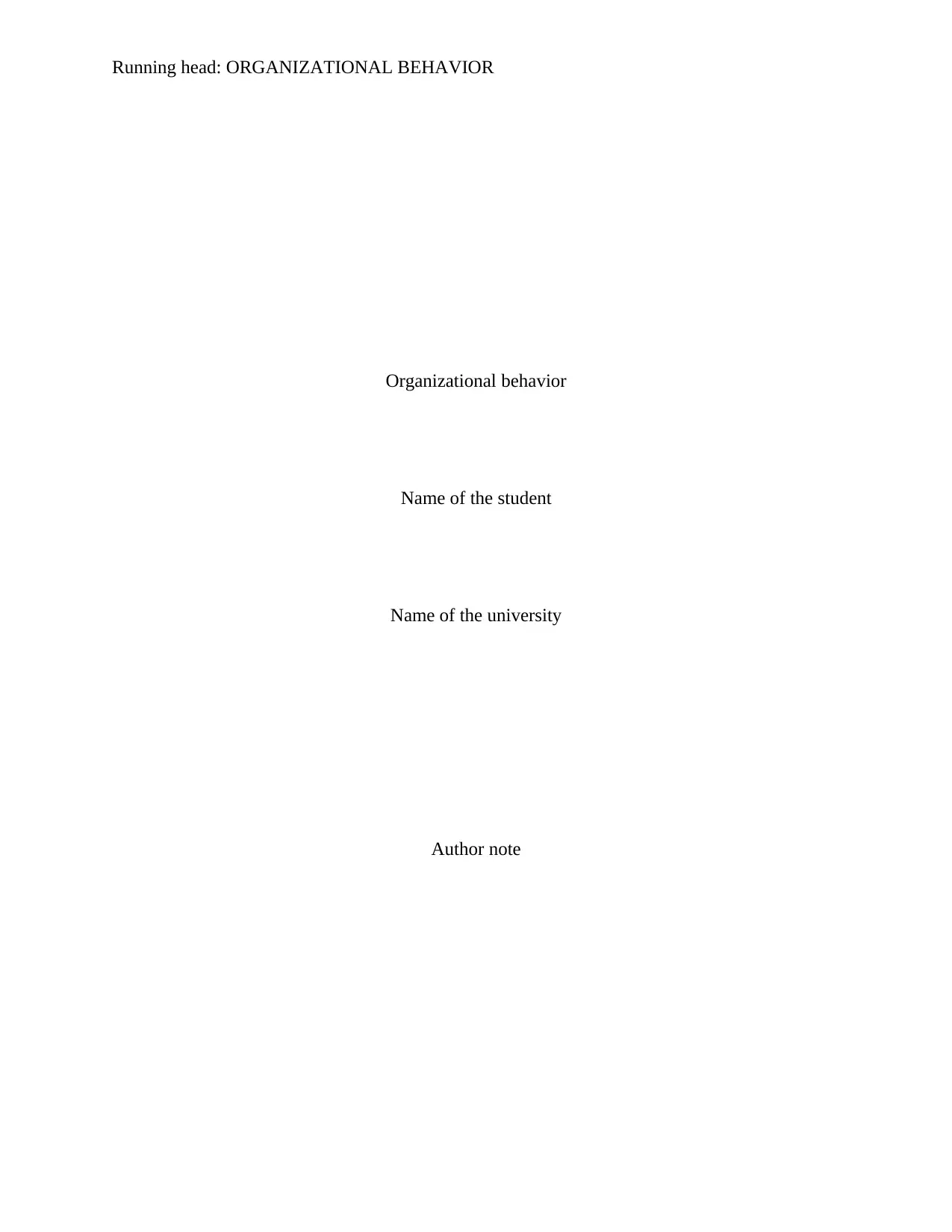
Running head: ORGANIZATIONAL BEHAVIOR
Organizational behavior
Name of the student
Name of the university
Author note
Organizational behavior
Name of the student
Name of the university
Author note
Paraphrase This Document
Need a fresh take? Get an instant paraphrase of this document with our AI Paraphraser
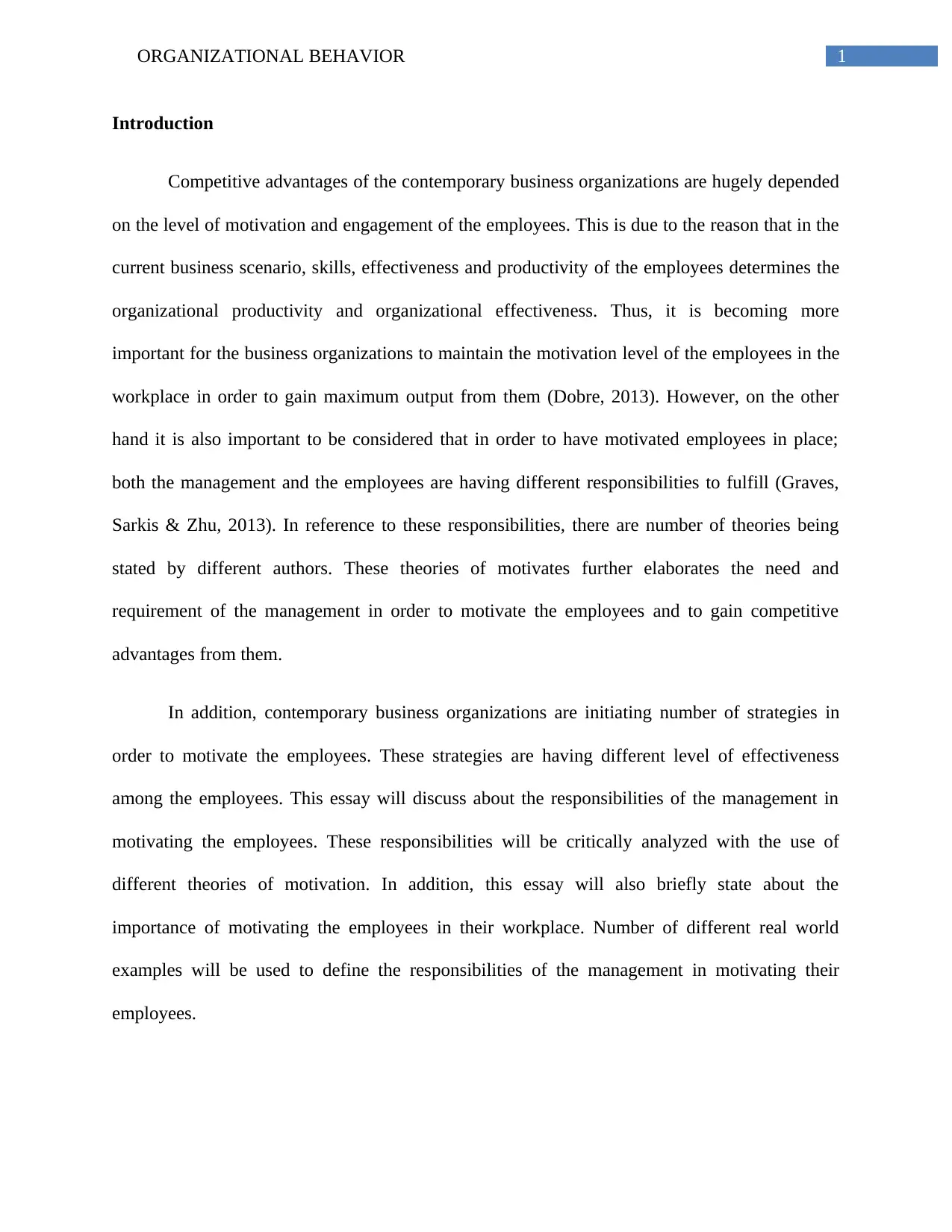
1ORGANIZATIONAL BEHAVIOR
Introduction
Competitive advantages of the contemporary business organizations are hugely depended
on the level of motivation and engagement of the employees. This is due to the reason that in the
current business scenario, skills, effectiveness and productivity of the employees determines the
organizational productivity and organizational effectiveness. Thus, it is becoming more
important for the business organizations to maintain the motivation level of the employees in the
workplace in order to gain maximum output from them (Dobre, 2013). However, on the other
hand it is also important to be considered that in order to have motivated employees in place;
both the management and the employees are having different responsibilities to fulfill (Graves,
Sarkis & Zhu, 2013). In reference to these responsibilities, there are number of theories being
stated by different authors. These theories of motivates further elaborates the need and
requirement of the management in order to motivate the employees and to gain competitive
advantages from them.
In addition, contemporary business organizations are initiating number of strategies in
order to motivate the employees. These strategies are having different level of effectiveness
among the employees. This essay will discuss about the responsibilities of the management in
motivating the employees. These responsibilities will be critically analyzed with the use of
different theories of motivation. In addition, this essay will also briefly state about the
importance of motivating the employees in their workplace. Number of different real world
examples will be used to define the responsibilities of the management in motivating their
employees.
Introduction
Competitive advantages of the contemporary business organizations are hugely depended
on the level of motivation and engagement of the employees. This is due to the reason that in the
current business scenario, skills, effectiveness and productivity of the employees determines the
organizational productivity and organizational effectiveness. Thus, it is becoming more
important for the business organizations to maintain the motivation level of the employees in the
workplace in order to gain maximum output from them (Dobre, 2013). However, on the other
hand it is also important to be considered that in order to have motivated employees in place;
both the management and the employees are having different responsibilities to fulfill (Graves,
Sarkis & Zhu, 2013). In reference to these responsibilities, there are number of theories being
stated by different authors. These theories of motivates further elaborates the need and
requirement of the management in order to motivate the employees and to gain competitive
advantages from them.
In addition, contemporary business organizations are initiating number of strategies in
order to motivate the employees. These strategies are having different level of effectiveness
among the employees. This essay will discuss about the responsibilities of the management in
motivating the employees. These responsibilities will be critically analyzed with the use of
different theories of motivation. In addition, this essay will also briefly state about the
importance of motivating the employees in their workplace. Number of different real world
examples will be used to define the responsibilities of the management in motivating their
employees.
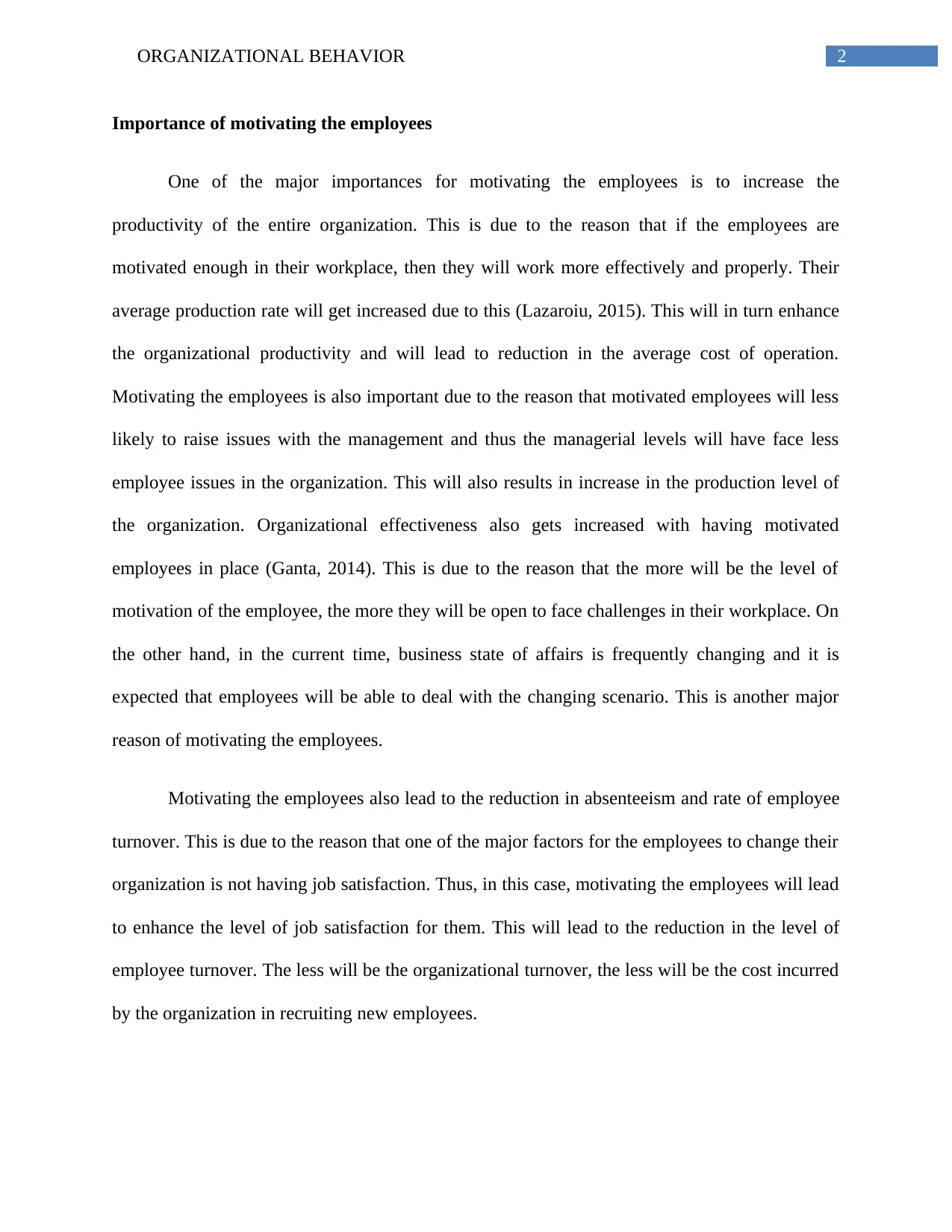
2ORGANIZATIONAL BEHAVIOR
Importance of motivating the employees
One of the major importances for motivating the employees is to increase the
productivity of the entire organization. This is due to the reason that if the employees are
motivated enough in their workplace, then they will work more effectively and properly. Their
average production rate will get increased due to this (Lazaroiu, 2015). This will in turn enhance
the organizational productivity and will lead to reduction in the average cost of operation.
Motivating the employees is also important due to the reason that motivated employees will less
likely to raise issues with the management and thus the managerial levels will have face less
employee issues in the organization. This will also results in increase in the production level of
the organization. Organizational effectiveness also gets increased with having motivated
employees in place (Ganta, 2014). This is due to the reason that the more will be the level of
motivation of the employee, the more they will be open to face challenges in their workplace. On
the other hand, in the current time, business state of affairs is frequently changing and it is
expected that employees will be able to deal with the changing scenario. This is another major
reason of motivating the employees.
Motivating the employees also lead to the reduction in absenteeism and rate of employee
turnover. This is due to the reason that one of the major factors for the employees to change their
organization is not having job satisfaction. Thus, in this case, motivating the employees will lead
to enhance the level of job satisfaction for them. This will lead to the reduction in the level of
employee turnover. The less will be the organizational turnover, the less will be the cost incurred
by the organization in recruiting new employees.
Importance of motivating the employees
One of the major importances for motivating the employees is to increase the
productivity of the entire organization. This is due to the reason that if the employees are
motivated enough in their workplace, then they will work more effectively and properly. Their
average production rate will get increased due to this (Lazaroiu, 2015). This will in turn enhance
the organizational productivity and will lead to reduction in the average cost of operation.
Motivating the employees is also important due to the reason that motivated employees will less
likely to raise issues with the management and thus the managerial levels will have face less
employee issues in the organization. This will also results in increase in the production level of
the organization. Organizational effectiveness also gets increased with having motivated
employees in place (Ganta, 2014). This is due to the reason that the more will be the level of
motivation of the employee, the more they will be open to face challenges in their workplace. On
the other hand, in the current time, business state of affairs is frequently changing and it is
expected that employees will be able to deal with the changing scenario. This is another major
reason of motivating the employees.
Motivating the employees also lead to the reduction in absenteeism and rate of employee
turnover. This is due to the reason that one of the major factors for the employees to change their
organization is not having job satisfaction. Thus, in this case, motivating the employees will lead
to enhance the level of job satisfaction for them. This will lead to the reduction in the level of
employee turnover. The less will be the organizational turnover, the less will be the cost incurred
by the organization in recruiting new employees.
⊘ This is a preview!⊘
Do you want full access?
Subscribe today to unlock all pages.

Trusted by 1+ million students worldwide
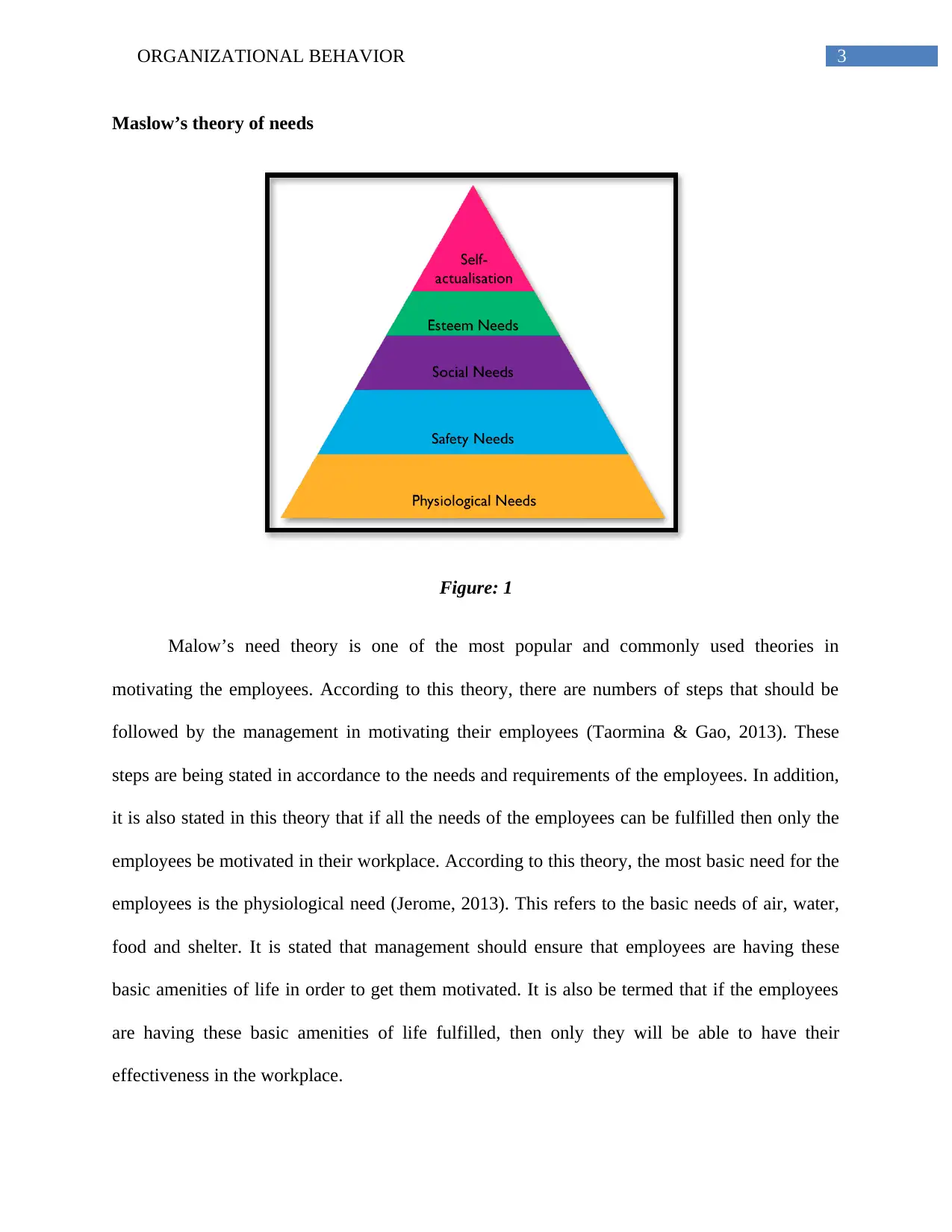
3ORGANIZATIONAL BEHAVIOR
Maslow’s theory of needs
Figure: 1
Malow’s need theory is one of the most popular and commonly used theories in
motivating the employees. According to this theory, there are numbers of steps that should be
followed by the management in motivating their employees (Taormina & Gao, 2013). These
steps are being stated in accordance to the needs and requirements of the employees. In addition,
it is also stated in this theory that if all the needs of the employees can be fulfilled then only the
employees be motivated in their workplace. According to this theory, the most basic need for the
employees is the physiological need (Jerome, 2013). This refers to the basic needs of air, water,
food and shelter. It is stated that management should ensure that employees are having these
basic amenities of life in order to get them motivated. It is also be termed that if the employees
are having these basic amenities of life fulfilled, then only they will be able to have their
effectiveness in the workplace.
Maslow’s theory of needs
Figure: 1
Malow’s need theory is one of the most popular and commonly used theories in
motivating the employees. According to this theory, there are numbers of steps that should be
followed by the management in motivating their employees (Taormina & Gao, 2013). These
steps are being stated in accordance to the needs and requirements of the employees. In addition,
it is also stated in this theory that if all the needs of the employees can be fulfilled then only the
employees be motivated in their workplace. According to this theory, the most basic need for the
employees is the physiological need (Jerome, 2013). This refers to the basic needs of air, water,
food and shelter. It is stated that management should ensure that employees are having these
basic amenities of life in order to get them motivated. It is also be termed that if the employees
are having these basic amenities of life fulfilled, then only they will be able to have their
effectiveness in the workplace.
Paraphrase This Document
Need a fresh take? Get an instant paraphrase of this document with our AI Paraphraser
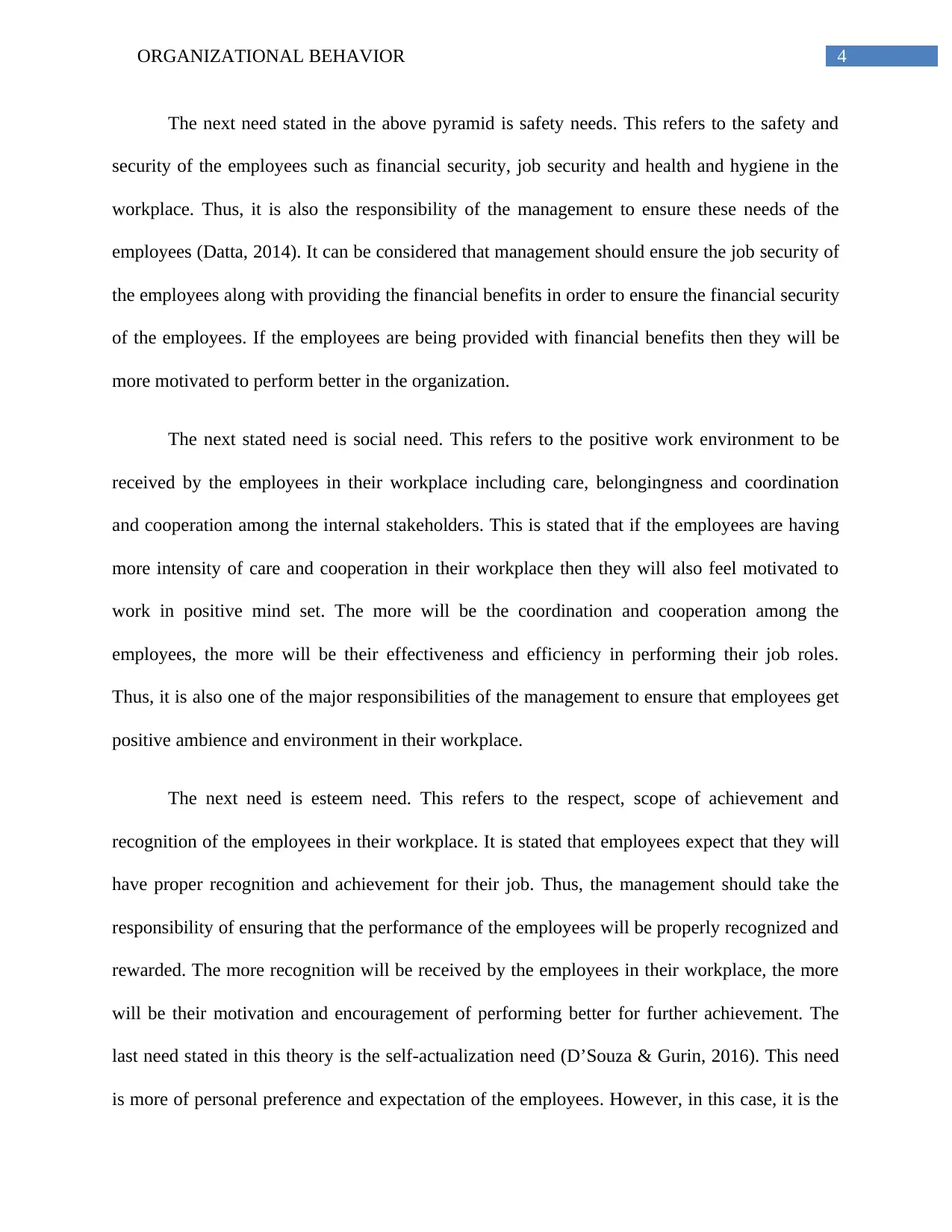
4ORGANIZATIONAL BEHAVIOR
The next need stated in the above pyramid is safety needs. This refers to the safety and
security of the employees such as financial security, job security and health and hygiene in the
workplace. Thus, it is also the responsibility of the management to ensure these needs of the
employees (Datta, 2014). It can be considered that management should ensure the job security of
the employees along with providing the financial benefits in order to ensure the financial security
of the employees. If the employees are being provided with financial benefits then they will be
more motivated to perform better in the organization.
The next stated need is social need. This refers to the positive work environment to be
received by the employees in their workplace including care, belongingness and coordination
and cooperation among the internal stakeholders. This is stated that if the employees are having
more intensity of care and cooperation in their workplace then they will also feel motivated to
work in positive mind set. The more will be the coordination and cooperation among the
employees, the more will be their effectiveness and efficiency in performing their job roles.
Thus, it is also one of the major responsibilities of the management to ensure that employees get
positive ambience and environment in their workplace.
The next need is esteem need. This refers to the respect, scope of achievement and
recognition of the employees in their workplace. It is stated that employees expect that they will
have proper recognition and achievement for their job. Thus, the management should take the
responsibility of ensuring that the performance of the employees will be properly recognized and
rewarded. The more recognition will be received by the employees in their workplace, the more
will be their motivation and encouragement of performing better for further achievement. The
last need stated in this theory is the self-actualization need (D’Souza & Gurin, 2016). This need
is more of personal preference and expectation of the employees. However, in this case, it is the
The next need stated in the above pyramid is safety needs. This refers to the safety and
security of the employees such as financial security, job security and health and hygiene in the
workplace. Thus, it is also the responsibility of the management to ensure these needs of the
employees (Datta, 2014). It can be considered that management should ensure the job security of
the employees along with providing the financial benefits in order to ensure the financial security
of the employees. If the employees are being provided with financial benefits then they will be
more motivated to perform better in the organization.
The next stated need is social need. This refers to the positive work environment to be
received by the employees in their workplace including care, belongingness and coordination
and cooperation among the internal stakeholders. This is stated that if the employees are having
more intensity of care and cooperation in their workplace then they will also feel motivated to
work in positive mind set. The more will be the coordination and cooperation among the
employees, the more will be their effectiveness and efficiency in performing their job roles.
Thus, it is also one of the major responsibilities of the management to ensure that employees get
positive ambience and environment in their workplace.
The next need is esteem need. This refers to the respect, scope of achievement and
recognition of the employees in their workplace. It is stated that employees expect that they will
have proper recognition and achievement for their job. Thus, the management should take the
responsibility of ensuring that the performance of the employees will be properly recognized and
rewarded. The more recognition will be received by the employees in their workplace, the more
will be their motivation and encouragement of performing better for further achievement. The
last need stated in this theory is the self-actualization need (D’Souza & Gurin, 2016). This need
is more of personal preference and expectation of the employees. However, in this case, it is the
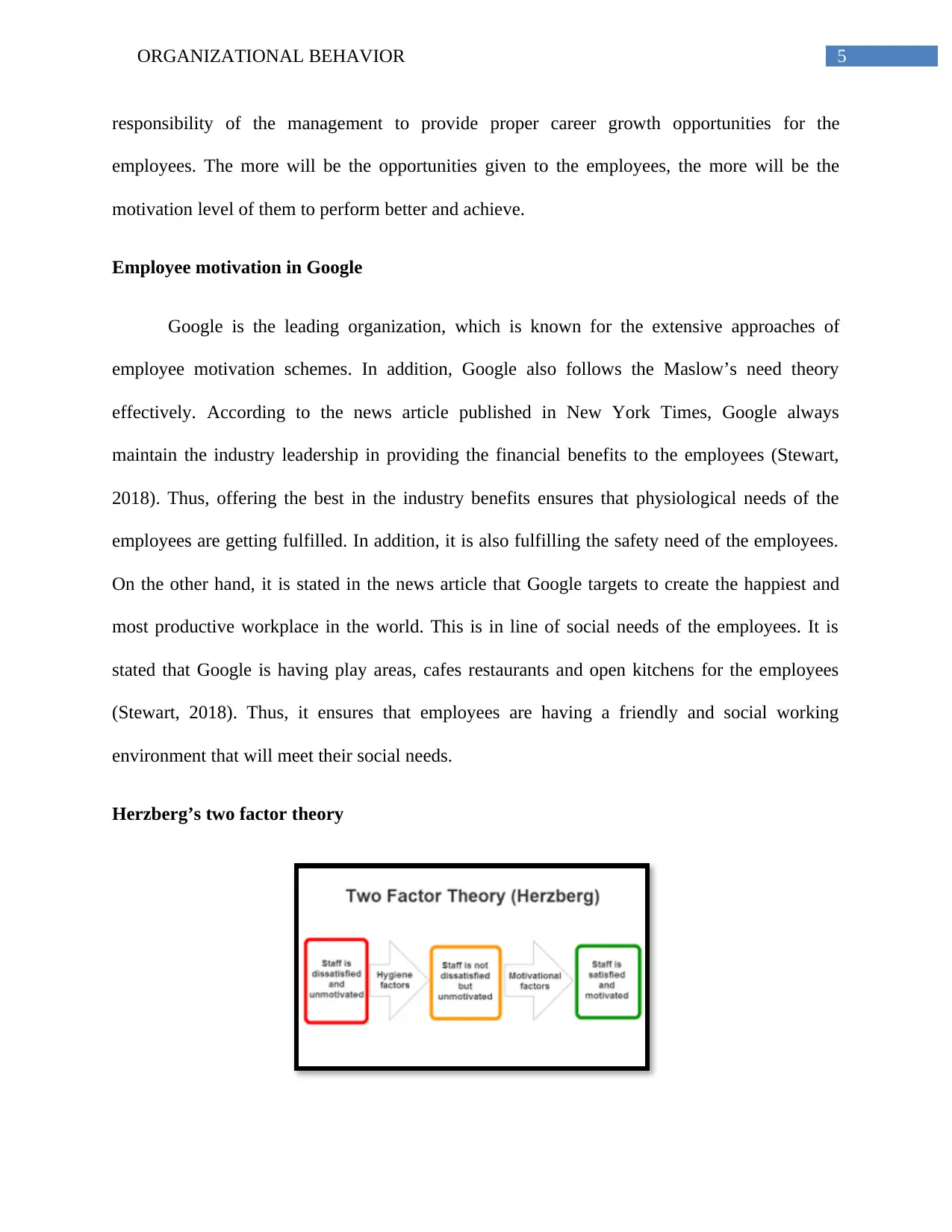
5ORGANIZATIONAL BEHAVIOR
responsibility of the management to provide proper career growth opportunities for the
employees. The more will be the opportunities given to the employees, the more will be the
motivation level of them to perform better and achieve.
Employee motivation in Google
Google is the leading organization, which is known for the extensive approaches of
employee motivation schemes. In addition, Google also follows the Maslow’s need theory
effectively. According to the news article published in New York Times, Google always
maintain the industry leadership in providing the financial benefits to the employees (Stewart,
2018). Thus, offering the best in the industry benefits ensures that physiological needs of the
employees are getting fulfilled. In addition, it is also fulfilling the safety need of the employees.
On the other hand, it is stated in the news article that Google targets to create the happiest and
most productive workplace in the world. This is in line of social needs of the employees. It is
stated that Google is having play areas, cafes restaurants and open kitchens for the employees
(Stewart, 2018). Thus, it ensures that employees are having a friendly and social working
environment that will meet their social needs.
Herzberg’s two factor theory
responsibility of the management to provide proper career growth opportunities for the
employees. The more will be the opportunities given to the employees, the more will be the
motivation level of them to perform better and achieve.
Employee motivation in Google
Google is the leading organization, which is known for the extensive approaches of
employee motivation schemes. In addition, Google also follows the Maslow’s need theory
effectively. According to the news article published in New York Times, Google always
maintain the industry leadership in providing the financial benefits to the employees (Stewart,
2018). Thus, offering the best in the industry benefits ensures that physiological needs of the
employees are getting fulfilled. In addition, it is also fulfilling the safety need of the employees.
On the other hand, it is stated in the news article that Google targets to create the happiest and
most productive workplace in the world. This is in line of social needs of the employees. It is
stated that Google is having play areas, cafes restaurants and open kitchens for the employees
(Stewart, 2018). Thus, it ensures that employees are having a friendly and social working
environment that will meet their social needs.
Herzberg’s two factor theory
⊘ This is a preview!⊘
Do you want full access?
Subscribe today to unlock all pages.

Trusted by 1+ million students worldwide
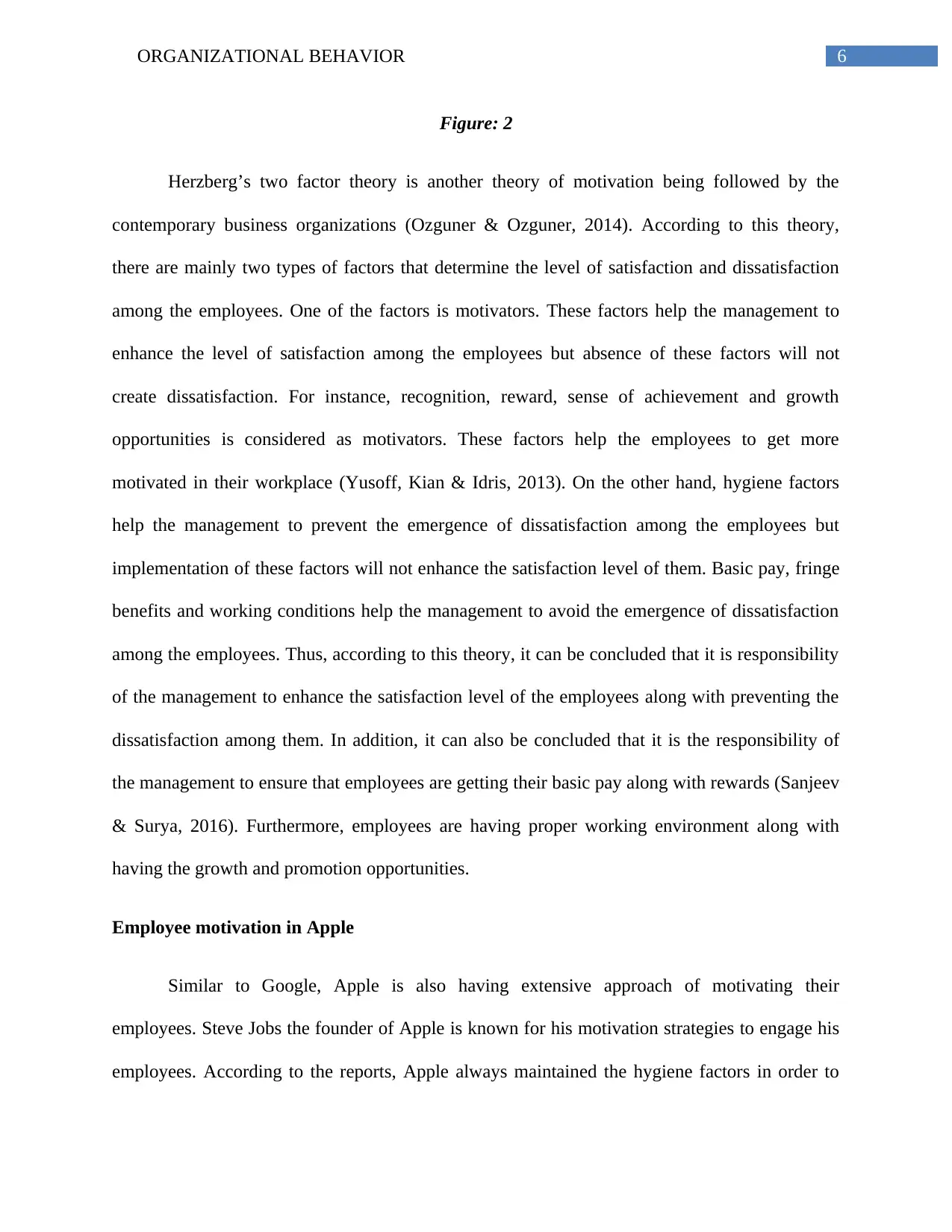
6ORGANIZATIONAL BEHAVIOR
Figure: 2
Herzberg’s two factor theory is another theory of motivation being followed by the
contemporary business organizations (Ozguner & Ozguner, 2014). According to this theory,
there are mainly two types of factors that determine the level of satisfaction and dissatisfaction
among the employees. One of the factors is motivators. These factors help the management to
enhance the level of satisfaction among the employees but absence of these factors will not
create dissatisfaction. For instance, recognition, reward, sense of achievement and growth
opportunities is considered as motivators. These factors help the employees to get more
motivated in their workplace (Yusoff, Kian & Idris, 2013). On the other hand, hygiene factors
help the management to prevent the emergence of dissatisfaction among the employees but
implementation of these factors will not enhance the satisfaction level of them. Basic pay, fringe
benefits and working conditions help the management to avoid the emergence of dissatisfaction
among the employees. Thus, according to this theory, it can be concluded that it is responsibility
of the management to enhance the satisfaction level of the employees along with preventing the
dissatisfaction among them. In addition, it can also be concluded that it is the responsibility of
the management to ensure that employees are getting their basic pay along with rewards (Sanjeev
& Surya, 2016). Furthermore, employees are having proper working environment along with
having the growth and promotion opportunities.
Employee motivation in Apple
Similar to Google, Apple is also having extensive approach of motivating their
employees. Steve Jobs the founder of Apple is known for his motivation strategies to engage his
employees. According to the reports, Apple always maintained the hygiene factors in order to
Figure: 2
Herzberg’s two factor theory is another theory of motivation being followed by the
contemporary business organizations (Ozguner & Ozguner, 2014). According to this theory,
there are mainly two types of factors that determine the level of satisfaction and dissatisfaction
among the employees. One of the factors is motivators. These factors help the management to
enhance the level of satisfaction among the employees but absence of these factors will not
create dissatisfaction. For instance, recognition, reward, sense of achievement and growth
opportunities is considered as motivators. These factors help the employees to get more
motivated in their workplace (Yusoff, Kian & Idris, 2013). On the other hand, hygiene factors
help the management to prevent the emergence of dissatisfaction among the employees but
implementation of these factors will not enhance the satisfaction level of them. Basic pay, fringe
benefits and working conditions help the management to avoid the emergence of dissatisfaction
among the employees. Thus, according to this theory, it can be concluded that it is responsibility
of the management to enhance the satisfaction level of the employees along with preventing the
dissatisfaction among them. In addition, it can also be concluded that it is the responsibility of
the management to ensure that employees are getting their basic pay along with rewards (Sanjeev
& Surya, 2016). Furthermore, employees are having proper working environment along with
having the growth and promotion opportunities.
Employee motivation in Apple
Similar to Google, Apple is also having extensive approach of motivating their
employees. Steve Jobs the founder of Apple is known for his motivation strategies to engage his
employees. According to the reports, Apple always maintained the hygiene factors in order to
Paraphrase This Document
Need a fresh take? Get an instant paraphrase of this document with our AI Paraphraser
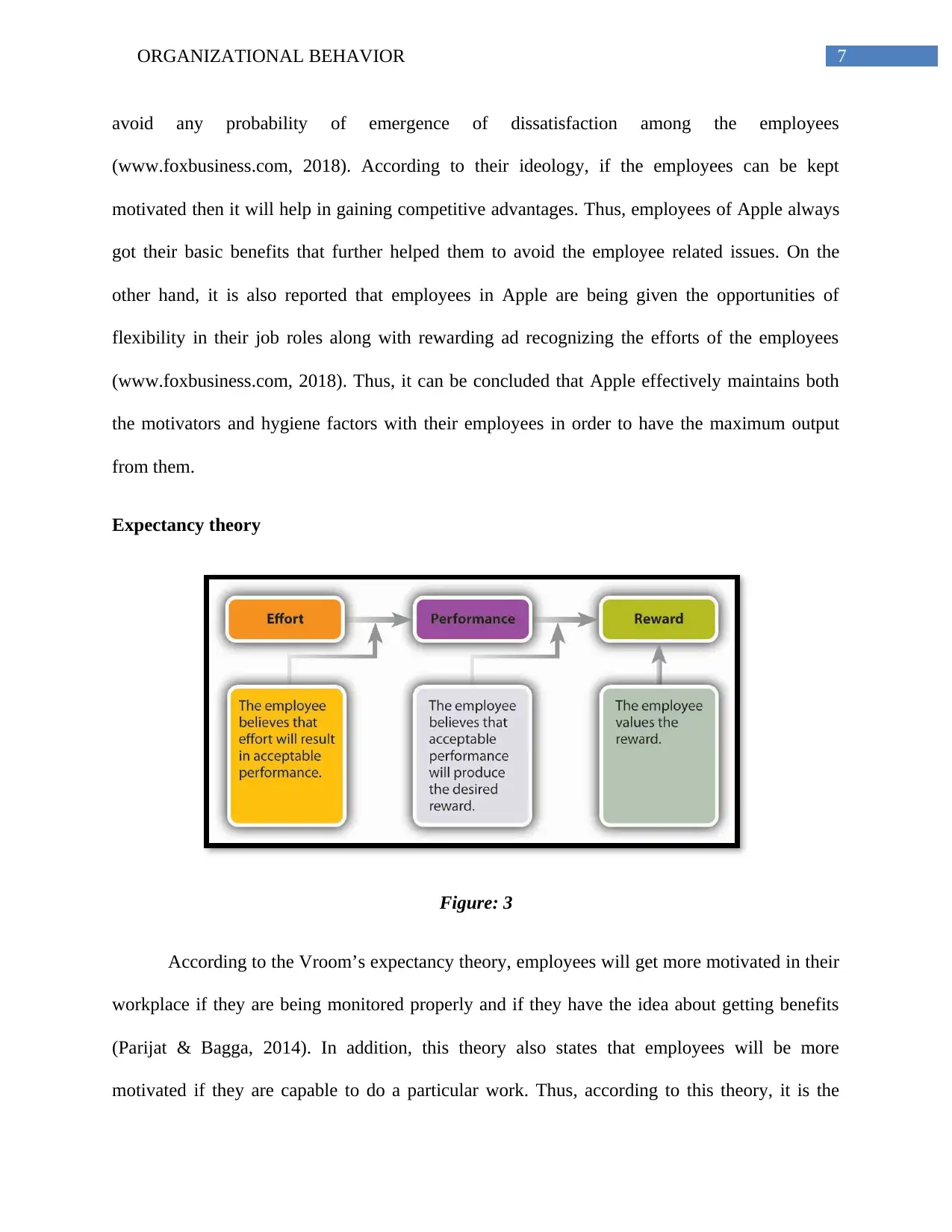
7ORGANIZATIONAL BEHAVIOR
avoid any probability of emergence of dissatisfaction among the employees
(www.foxbusiness.com, 2018). According to their ideology, if the employees can be kept
motivated then it will help in gaining competitive advantages. Thus, employees of Apple always
got their basic benefits that further helped them to avoid the employee related issues. On the
other hand, it is also reported that employees in Apple are being given the opportunities of
flexibility in their job roles along with rewarding ad recognizing the efforts of the employees
(www.foxbusiness.com, 2018). Thus, it can be concluded that Apple effectively maintains both
the motivators and hygiene factors with their employees in order to have the maximum output
from them.
Expectancy theory
Figure: 3
According to the Vroom’s expectancy theory, employees will get more motivated in their
workplace if they are being monitored properly and if they have the idea about getting benefits
(Parijat & Bagga, 2014). In addition, this theory also states that employees will be more
motivated if they are capable to do a particular work. Thus, according to this theory, it is the
avoid any probability of emergence of dissatisfaction among the employees
(www.foxbusiness.com, 2018). According to their ideology, if the employees can be kept
motivated then it will help in gaining competitive advantages. Thus, employees of Apple always
got their basic benefits that further helped them to avoid the employee related issues. On the
other hand, it is also reported that employees in Apple are being given the opportunities of
flexibility in their job roles along with rewarding ad recognizing the efforts of the employees
(www.foxbusiness.com, 2018). Thus, it can be concluded that Apple effectively maintains both
the motivators and hygiene factors with their employees in order to have the maximum output
from them.
Expectancy theory
Figure: 3
According to the Vroom’s expectancy theory, employees will get more motivated in their
workplace if they are being monitored properly and if they have the idea about getting benefits
(Parijat & Bagga, 2014). In addition, this theory also states that employees will be more
motivated if they are capable to do a particular work. Thus, according to this theory, it is the
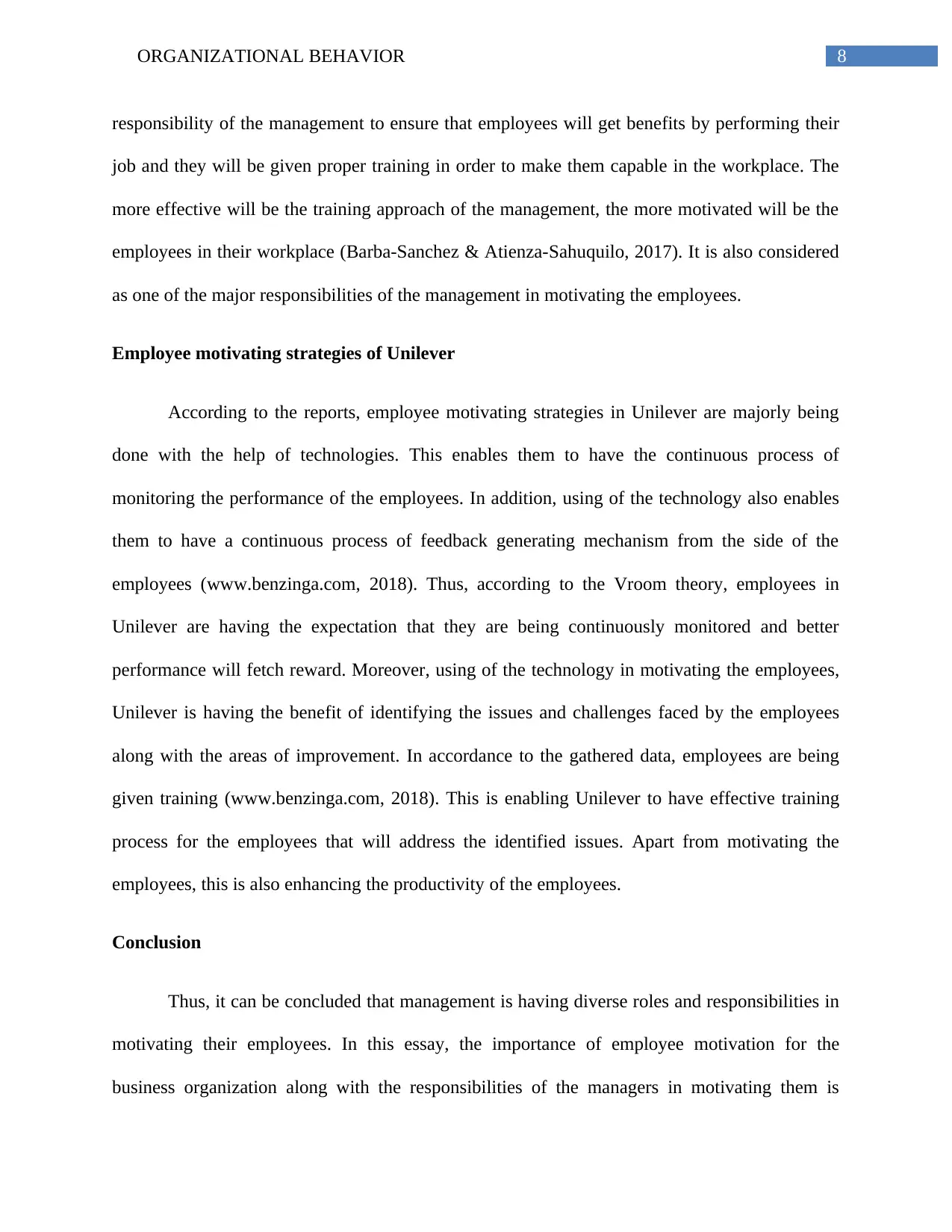
8ORGANIZATIONAL BEHAVIOR
responsibility of the management to ensure that employees will get benefits by performing their
job and they will be given proper training in order to make them capable in the workplace. The
more effective will be the training approach of the management, the more motivated will be the
employees in their workplace (Barba-Sanchez & Atienza-Sahuquilo, 2017). It is also considered
as one of the major responsibilities of the management in motivating the employees.
Employee motivating strategies of Unilever
According to the reports, employee motivating strategies in Unilever are majorly being
done with the help of technologies. This enables them to have the continuous process of
monitoring the performance of the employees. In addition, using of the technology also enables
them to have a continuous process of feedback generating mechanism from the side of the
employees (www.benzinga.com, 2018). Thus, according to the Vroom theory, employees in
Unilever are having the expectation that they are being continuously monitored and better
performance will fetch reward. Moreover, using of the technology in motivating the employees,
Unilever is having the benefit of identifying the issues and challenges faced by the employees
along with the areas of improvement. In accordance to the gathered data, employees are being
given training (www.benzinga.com, 2018). This is enabling Unilever to have effective training
process for the employees that will address the identified issues. Apart from motivating the
employees, this is also enhancing the productivity of the employees.
Conclusion
Thus, it can be concluded that management is having diverse roles and responsibilities in
motivating their employees. In this essay, the importance of employee motivation for the
business organization along with the responsibilities of the managers in motivating them is
responsibility of the management to ensure that employees will get benefits by performing their
job and they will be given proper training in order to make them capable in the workplace. The
more effective will be the training approach of the management, the more motivated will be the
employees in their workplace (Barba-Sanchez & Atienza-Sahuquilo, 2017). It is also considered
as one of the major responsibilities of the management in motivating the employees.
Employee motivating strategies of Unilever
According to the reports, employee motivating strategies in Unilever are majorly being
done with the help of technologies. This enables them to have the continuous process of
monitoring the performance of the employees. In addition, using of the technology also enables
them to have a continuous process of feedback generating mechanism from the side of the
employees (www.benzinga.com, 2018). Thus, according to the Vroom theory, employees in
Unilever are having the expectation that they are being continuously monitored and better
performance will fetch reward. Moreover, using of the technology in motivating the employees,
Unilever is having the benefit of identifying the issues and challenges faced by the employees
along with the areas of improvement. In accordance to the gathered data, employees are being
given training (www.benzinga.com, 2018). This is enabling Unilever to have effective training
process for the employees that will address the identified issues. Apart from motivating the
employees, this is also enhancing the productivity of the employees.
Conclusion
Thus, it can be concluded that management is having diverse roles and responsibilities in
motivating their employees. In this essay, the importance of employee motivation for the
business organization along with the responsibilities of the managers in motivating them is
⊘ This is a preview!⊘
Do you want full access?
Subscribe today to unlock all pages.

Trusted by 1+ million students worldwide
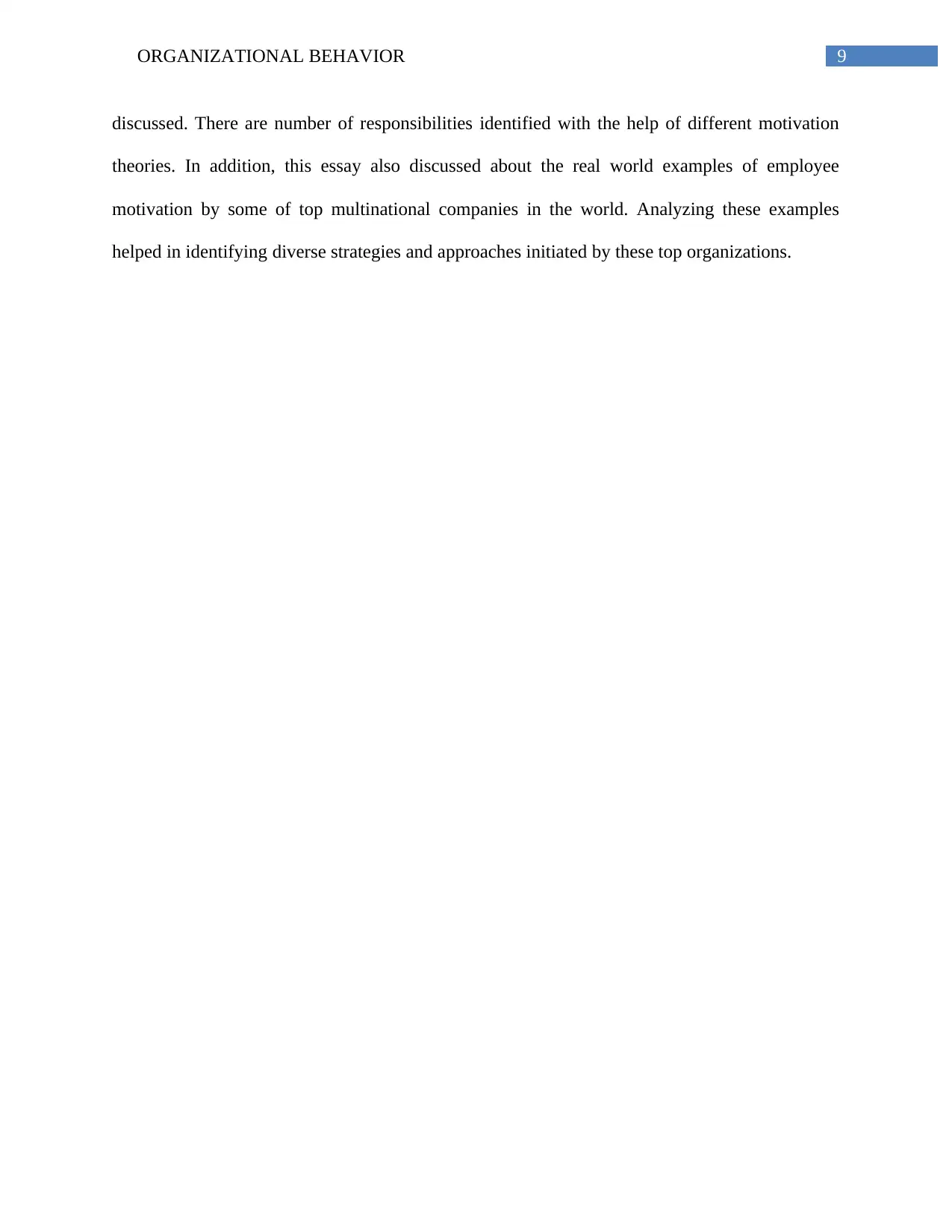
9ORGANIZATIONAL BEHAVIOR
discussed. There are number of responsibilities identified with the help of different motivation
theories. In addition, this essay also discussed about the real world examples of employee
motivation by some of top multinational companies in the world. Analyzing these examples
helped in identifying diverse strategies and approaches initiated by these top organizations.
discussed. There are number of responsibilities identified with the help of different motivation
theories. In addition, this essay also discussed about the real world examples of employee
motivation by some of top multinational companies in the world. Analyzing these examples
helped in identifying diverse strategies and approaches initiated by these top organizations.
Paraphrase This Document
Need a fresh take? Get an instant paraphrase of this document with our AI Paraphraser
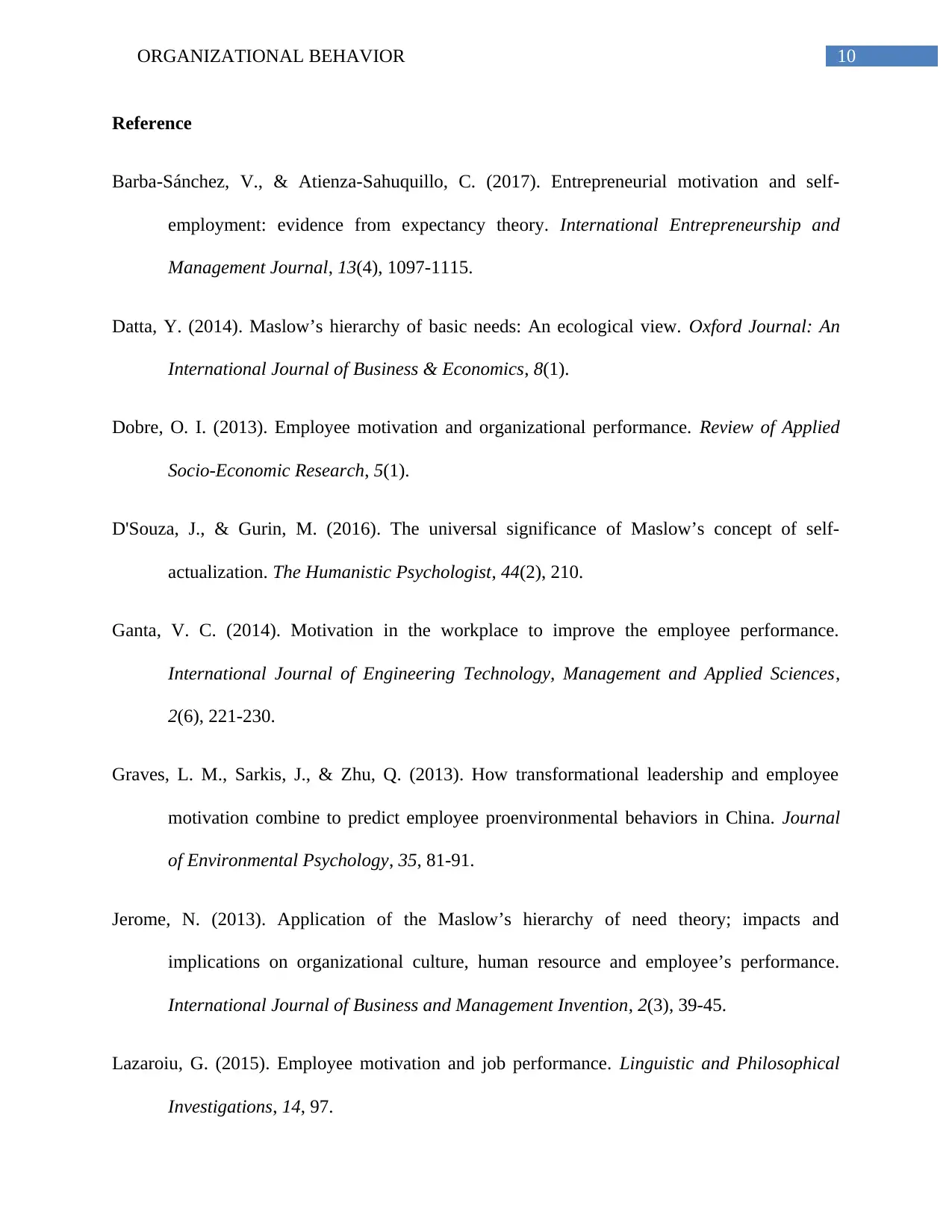
10ORGANIZATIONAL BEHAVIOR
Reference
Barba-Sánchez, V., & Atienza-Sahuquillo, C. (2017). Entrepreneurial motivation and self-
employment: evidence from expectancy theory. International Entrepreneurship and
Management Journal, 13(4), 1097-1115.
Datta, Y. (2014). Maslow’s hierarchy of basic needs: An ecological view. Oxford Journal: An
International Journal of Business & Economics, 8(1).
Dobre, O. I. (2013). Employee motivation and organizational performance. Review of Applied
Socio-Economic Research, 5(1).
D'Souza, J., & Gurin, M. (2016). The universal significance of Maslow’s concept of self-
actualization. The Humanistic Psychologist, 44(2), 210.
Ganta, V. C. (2014). Motivation in the workplace to improve the employee performance.
International Journal of Engineering Technology, Management and Applied Sciences,
2(6), 221-230.
Graves, L. M., Sarkis, J., & Zhu, Q. (2013). How transformational leadership and employee
motivation combine to predict employee proenvironmental behaviors in China. Journal
of Environmental Psychology, 35, 81-91.
Jerome, N. (2013). Application of the Maslow’s hierarchy of need theory; impacts and
implications on organizational culture, human resource and employee’s performance.
International Journal of Business and Management Invention, 2(3), 39-45.
Lazaroiu, G. (2015). Employee motivation and job performance. Linguistic and Philosophical
Investigations, 14, 97.
Reference
Barba-Sánchez, V., & Atienza-Sahuquillo, C. (2017). Entrepreneurial motivation and self-
employment: evidence from expectancy theory. International Entrepreneurship and
Management Journal, 13(4), 1097-1115.
Datta, Y. (2014). Maslow’s hierarchy of basic needs: An ecological view. Oxford Journal: An
International Journal of Business & Economics, 8(1).
Dobre, O. I. (2013). Employee motivation and organizational performance. Review of Applied
Socio-Economic Research, 5(1).
D'Souza, J., & Gurin, M. (2016). The universal significance of Maslow’s concept of self-
actualization. The Humanistic Psychologist, 44(2), 210.
Ganta, V. C. (2014). Motivation in the workplace to improve the employee performance.
International Journal of Engineering Technology, Management and Applied Sciences,
2(6), 221-230.
Graves, L. M., Sarkis, J., & Zhu, Q. (2013). How transformational leadership and employee
motivation combine to predict employee proenvironmental behaviors in China. Journal
of Environmental Psychology, 35, 81-91.
Jerome, N. (2013). Application of the Maslow’s hierarchy of need theory; impacts and
implications on organizational culture, human resource and employee’s performance.
International Journal of Business and Management Invention, 2(3), 39-45.
Lazaroiu, G. (2015). Employee motivation and job performance. Linguistic and Philosophical
Investigations, 14, 97.
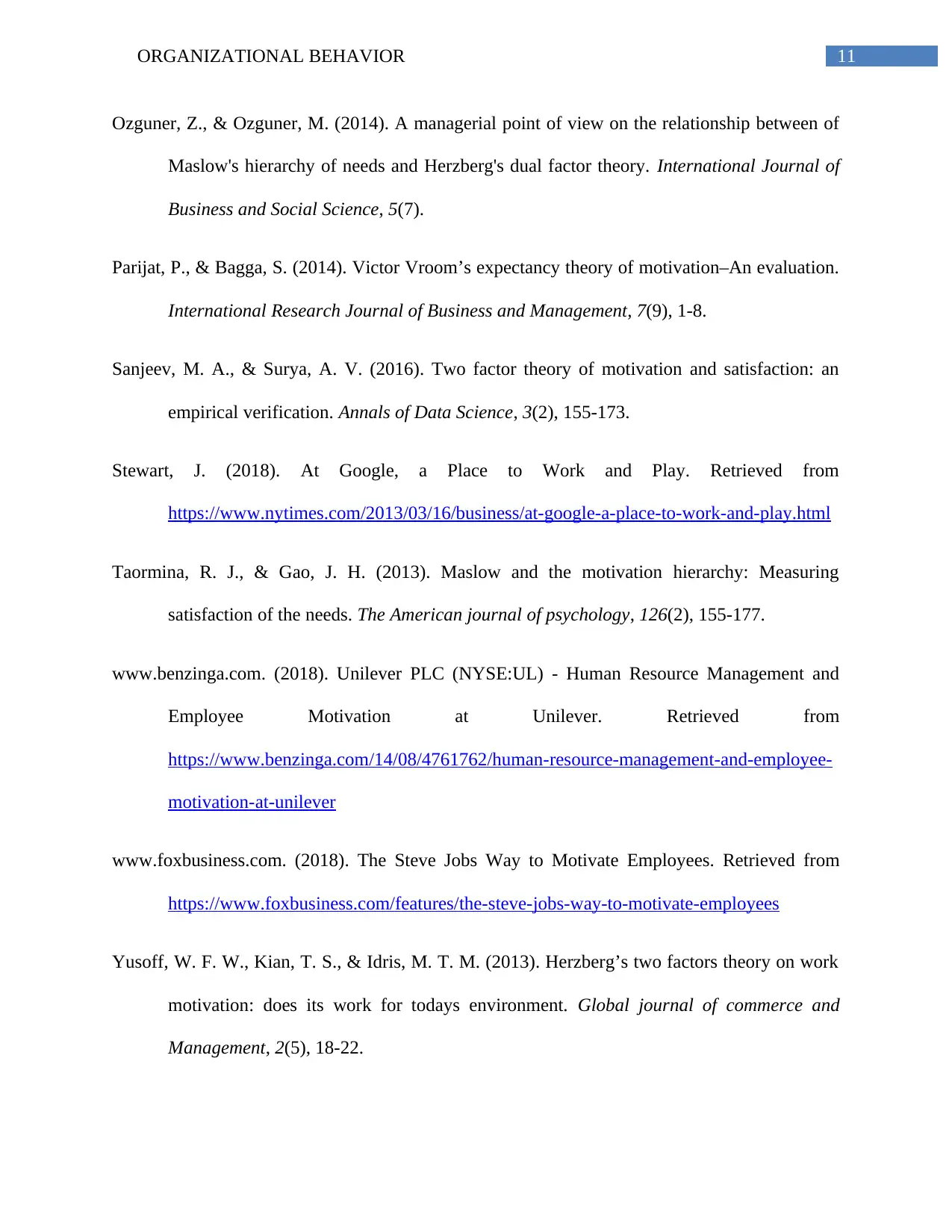
11ORGANIZATIONAL BEHAVIOR
Ozguner, Z., & Ozguner, M. (2014). A managerial point of view on the relationship between of
Maslow's hierarchy of needs and Herzberg's dual factor theory. International Journal of
Business and Social Science, 5(7).
Parijat, P., & Bagga, S. (2014). Victor Vroom’s expectancy theory of motivation–An evaluation.
International Research Journal of Business and Management, 7(9), 1-8.
Sanjeev, M. A., & Surya, A. V. (2016). Two factor theory of motivation and satisfaction: an
empirical verification. Annals of Data Science, 3(2), 155-173.
Stewart, J. (2018). At Google, a Place to Work and Play. Retrieved from
https://www.nytimes.com/2013/03/16/business/at-google-a-place-to-work-and-play.html
Taormina, R. J., & Gao, J. H. (2013). Maslow and the motivation hierarchy: Measuring
satisfaction of the needs. The American journal of psychology, 126(2), 155-177.
www.benzinga.com. (2018). Unilever PLC (NYSE:UL) - Human Resource Management and
Employee Motivation at Unilever. Retrieved from
https://www.benzinga.com/14/08/4761762/human-resource-management-and-employee-
motivation-at-unilever
www.foxbusiness.com. (2018). The Steve Jobs Way to Motivate Employees. Retrieved from
https://www.foxbusiness.com/features/the-steve-jobs-way-to-motivate-employees
Yusoff, W. F. W., Kian, T. S., & Idris, M. T. M. (2013). Herzberg’s two factors theory on work
motivation: does its work for todays environment. Global journal of commerce and
Management, 2(5), 18-22.
Ozguner, Z., & Ozguner, M. (2014). A managerial point of view on the relationship between of
Maslow's hierarchy of needs and Herzberg's dual factor theory. International Journal of
Business and Social Science, 5(7).
Parijat, P., & Bagga, S. (2014). Victor Vroom’s expectancy theory of motivation–An evaluation.
International Research Journal of Business and Management, 7(9), 1-8.
Sanjeev, M. A., & Surya, A. V. (2016). Two factor theory of motivation and satisfaction: an
empirical verification. Annals of Data Science, 3(2), 155-173.
Stewart, J. (2018). At Google, a Place to Work and Play. Retrieved from
https://www.nytimes.com/2013/03/16/business/at-google-a-place-to-work-and-play.html
Taormina, R. J., & Gao, J. H. (2013). Maslow and the motivation hierarchy: Measuring
satisfaction of the needs. The American journal of psychology, 126(2), 155-177.
www.benzinga.com. (2018). Unilever PLC (NYSE:UL) - Human Resource Management and
Employee Motivation at Unilever. Retrieved from
https://www.benzinga.com/14/08/4761762/human-resource-management-and-employee-
motivation-at-unilever
www.foxbusiness.com. (2018). The Steve Jobs Way to Motivate Employees. Retrieved from
https://www.foxbusiness.com/features/the-steve-jobs-way-to-motivate-employees
Yusoff, W. F. W., Kian, T. S., & Idris, M. T. M. (2013). Herzberg’s two factors theory on work
motivation: does its work for todays environment. Global journal of commerce and
Management, 2(5), 18-22.
⊘ This is a preview!⊘
Do you want full access?
Subscribe today to unlock all pages.

Trusted by 1+ million students worldwide
1 out of 12
Related Documents
Your All-in-One AI-Powered Toolkit for Academic Success.
+13062052269
info@desklib.com
Available 24*7 on WhatsApp / Email
![[object Object]](/_next/static/media/star-bottom.7253800d.svg)
Unlock your academic potential
Copyright © 2020–2025 A2Z Services. All Rights Reserved. Developed and managed by ZUCOL.





